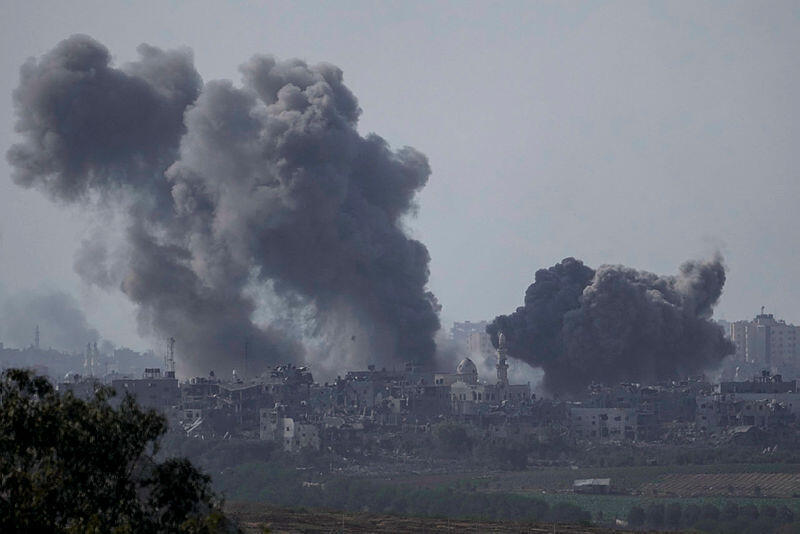
ISRAEL AT WAR
X factor: Independent social media influencers leave mainstream media in their dust in Gaza war information battle
According to a report by the University of Washington, seven independent accounts that do not adhere to the rules of journalistic ethics received 1.6 billion views in the first three days of the war - an average of 872,000 views per post. This is a significantly higher number than the views of posts on CNN, Reuters, BBC or the New York Times, which had an average of 376,000 views per post
Seven independent X (formerly Twitter) accounts are responsible for a significant part of the discourse surrounding the Israel-Hamas war. Their posts generated 1.6 billion views in the first three days of the war - a significantly larger number than the accounts of traditional media outlets such as CNN and the New York Times. This according to a report published this weekend by researchers at the University of Washington. Although the seven include accounts of supporters of Israel alongside supporters of Hamas, their reliance on spreading sensational and unverified information is a decisive factor in the spread of fake news and incitement against Israel.
The current war has seen production and distribution of disinformation and incitement on an unprecedented scale regarding Israel. In order to map the resulting discourse, the researchers first sought to identify the X accounts that had the greatest influence on it. For this purpose, they used the platform's search interface to identify all the posts that mention keywords such as "Israel", "Hamas" and "Gaza", which were published between October 7 and 10 and gained more than 500 likes. The researchers then summed up the number of views of each post, and compiled a list of the ten accounts with the most exposure.
This list included two accounts whose focus is not news (Elon Musk's, which was in 7th place, and the official account of the US president, which came in 10th place), and one account that does not publish in English, who were removed. The final list consists of seven accounts, none of which are traditional or recognized media, which the researchers call the "new elite". "It is a small group of users who are responsible for a significant amount of the content about the conflict seen on Twitter," they explained.
So, for example, the most popular account, @visegrad24, published 399 posts that gained more than 371.77 million views. The seventh-place account, @censoredmen, published 111 posts that garnered more than 98.27 million views.
The exposure to these accounts is significantly greater than that of traditional media outlets on Twitter, such as CNN, the New York Times, the BBC and Reuters. According to the researchers, the six accounts of these four media outlets (CNN and BBC have two accounts each that were tested, these are all the accounts of traditional media outlets that appear in the list of the 100 most popular accounts in X), created in the first three days of the war 298 posts that were viewed 112 million times (376,000 views on average per post). On the other hand, the "new elite" accounts published 1,834 tweets that were viewed 1.6 billion times (872,000 views on average per post).
And this, even though the traditional media accounts have a much larger number of followers. CNN's @CNNbrk has 63.8 million followers, the New York Times 55 million and Reuters 25.7 million, while @spectatorindex, ranked fourth on the researchers' list of influential accounts, has only 2.5 million followers, and the #1 account @visegrad24 only 641,000 followers.
According to the researchers, the accounts of the new elite are relatively new accounts, created in 2020 or later, except for one opened in 2013 and another opened in 2017. Most of them managed to increase their exposure in a relatively short time thanks to practical support from the controlling owner of X, Elon Musk. On various occasions, Musk responded to the posts of all but one of the accounts, sometimes dozens of times. A comment increases the exposure of the post, as it brings it to the timeline of Musk's 160 million followers.
In addition, in a controversial move, Musk also recommended following two of the accounts on the list, which are known for spreading fake news. Musk also follows these two accounts, and two other accounts on the list.
The method of operation of the accounts also helps the large distribution of their content. According to the researchers, many times they publish "breaking" news that is unfounded or without linking to its source. "Most of these accounts post tweets that start with words like BREAKING, JUST IN or NEW," they wrote. "Some of them add an emoji that emphasizes the nature of the report, such as a lightning strike or a siren. In most cases, the verification of the information is not based on traditional journalistic conventions. Only rarely do the citations include a reference to the source, or a source is mentioned without an external link to it - a practice that may have been intended to bypass a change in the algorithm that according to Musk harms the exposure of tweets with a link."
In addition, the content published by these accounts is often what the researchers call "emotionally charged". "The content includes a significant amount of violence. Five of the accounts published visual content - videos, photos or maps - many times. All accounts, except for one, covered in depth content showing aerial attacks and their results. Other content included images of victims of violence, homes and neighborhoods that were affected, global protests and statements by leaders about the crisis. The visual content often includes disturbing graphic images, such as video or images of the dead and injured," the researchers wrote.
They added that the ideological position presented by these accounts in the context of the current war is not uniform: "Some adopt a clear pro-Palestinian position, and others pro-Israel. Others amplify both sides in the conflict or report in a neutral tone. All but one of the accounts shared images of airstrikes in Israel and/or or in Gaza and their aftermath, but the images and videos of graphic violence they chose to share depended on their stance on the conflict. The group is united by its posting style, not by an individual position."
According to Revital Salomon, founder and CEO of The Shark Lady and an independent researcher of the fake news discourse and incitement in social media, the findings of the study show that it does not take many users to create a poison machine. "It is enough to establish a few strong sources, fake and real, and start sowing seeds," she explained. "From there, young propagandists will join independently, and all kinds of other toxins, some of which are fake and some of which are real, and all the rest like and retweet. You don't have to pay them anymore, they do it themselves.
"Israel is a small country. The cost of setting up such an array is negligible - bots and likes are bought cheaply, and I'm guessing that even the well-known fakes don't have to be paid a lot of money. Moreover, these fakes are used by those who operate them to spread messages of hatred and slander that cannot be published on official channels. This is how you take over the discourse, produce fakes in huge quantities and create an atmosphere where lying has no consequences."















